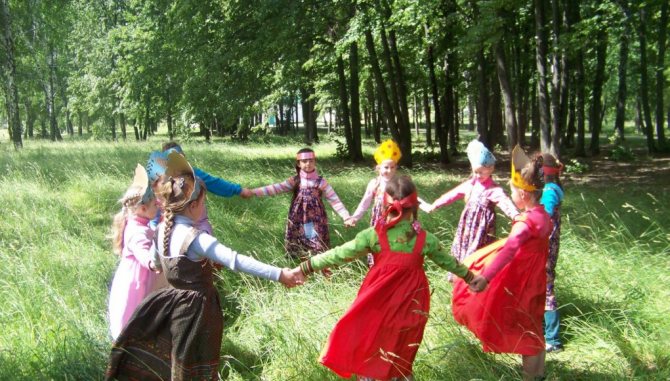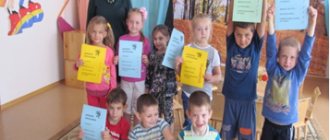Progress of the game:
Children stand in a circle. One child in the center of the circle. Children walk in a circle saying:
“Vanya - Vanya, you are in the forest
We call you - "Ay"
Vanya close your eyes
Find out who called you."
The children stop. A child in a circle closes his eyes. One of the children calls him by name. The driver guesses.
5. "Dawn - lightning"
.
Goal: Teaching children the ability to pronounce words clearly. Developing running strength. Cultivating interest in the game.
Progress of the game:
The players walk in a circle saying:
"Silence by the pond,
The water doesn't sway
The reeds don't make noise
Go to sleep, kids."
At the end of the words, the children stop, squat and lower their heads. Stay in this position for 10 seconds. Anyone who moves leaves the game. The game is repeated until one child remains - the winner.
3. "Cap"
.
Goal: Teaching children various dance movements. Cultivating friendly relations with each other.
Table: tasks and techniques for mastering round dance games
| Age group | Problems of round dance games | Organization of games | Mastering techniques |
| First youngest (1.5–3 years) |
| Kids learn to stand in a circle and dance in a circle. At the beginning of learning round dance games, it is recommended to place a toy in the center of the circle; it will serve as a guide for the children. At first, it is difficult for children of the second year of life to move clearly in a circle. To help them, you can mark a circle on the floor with electrical tape or stickers. The song is performed by adults: teacher, music director, physical education instructor, parents. They learn the round dance game several times a week. | Demonstration of the game by adults (demonstrated by the teacher and nanny, music director and teacher, etc.). |
| Second youngest (3–4 years) |
| Movements in a circle become more difficult:
The songs are performed by adults, encouraging children to sing along. The round dance game is learned daily: at leisure, during a music lesson, while walking. |
|
| Medium (4–5 years) |
| Children perform round dance songs on their own. In the first half of the day, the teacher learns the text with the children, in the second half - the movements. | |
| Senior (5–6 years old) |
| Older preschoolers quickly learn the words of songs. And the movements of round dance games become more complex: formation according to the rules and formation of figures appear. It is recommended to learn round dance movements in the first half of the day, and the lyrics of the song in the second. The new game should be repeated with the children 2-3 times during the day, for reinforcement - 1-2 times. |
|
| Preparatory (6–7 years) |
|
Round dance games belong to the folklore genre. Dance movements, plots and melodies of songs were invented by the people and have been preserved since ancient times. There are modern musical arrangements for round dance games; it is recommended to use them infrequently: at festive events or sports activities. The main meaning in learning round dances is contact with the world of Russian folk art. Let children feel the beauty of melodies and movements in their simplicity.

Children's round dance games are not only circular. The formation of the figures is borrowed from folk dance:
- “Wall to wall”, “Vorottsa”: participants line up in two lines and stand opposite each other.
For one musical phrase, the wall “finds” the wall and returns to its place, then the second line finds it. Moving towards is possible for both lines. To make a gate, the first participants in the lines join hands, and the round dance chains pass under them. In the round dance game “Like Ours at the Gate,” the chain of participants passes through the gate formed by the leaders - There is only one “circle”.
Russian folk round dances are characterized by movement in the direction of the sun, that is, clockwise. But in play dances the opposite direction is also possible. For example, in the Carousel game, participants spin the ribbons first in one direction, then turn around and spin the carousel. In games, it is possible to build two separate circles or a circle within a circle. Most often, round dances with preschoolers take place in a circle - “Snail”, “Cabbage”: twisting the round dance chain into a spiral.
This figure is created when one of the participants breaks the circle and begins to move in such a way that the chain wraps around an improvised center. This game also involves returning to the circle: the leader runs from the center of the cabbage (snail) and begins to move in a large circle. In the round dance game “Cabbage,” the leader twists the chain in the form of a spiral - “Snake”: the leader directs a round dance to form a zigzag pattern.
The round dance chain, when formed with a snake, draws a zigzag pattern
Experienced teachers usually introduce children to the circular formation of a round dance and games like “Snake”, rarely with “Cabbage” and “Vorottsy”. At events in the kindergarten that my children attend, I observed round dance games at Maslenitsa festivities and the autumn festival. Traditionally, round dances are held at New Year's matinees. The game form includes a round dance in which the content of the song determines the movements. In the younger group, the son and classmates were bunnies, for example, and in a round dance they jumped, wagged their tails, shook their ears. At sports festivals it was fun to play the snake round dance. Parents and children joined hands, and the leader (usually the most active dad is chosen) led this long chain at high speed with dashing patterns.
Progress of the game: Children stand in a circle and sing:
Birch henbane,
The poppy is green,
Hairy in the summer,
In winter it’s a bit knotty,
Where does she stand?
It's noisy there.
Birch girl
, standing in a circle, during the song, takes away the scarves from everyone playing, raises them above their heads and, when they sing:
Green birch,
Cheerful in spring,
Stands in the middle of a field
The leaves are rustling,
It thunders, it buzzes,
The golden rim rings, -
"Berezka"
depicts the rustling of leaves, the movement of branches - she rustles her dress, waves scarves over her head. Under the verdict:
And in the fall the roots of the birch tree dry out,
the leaves are falling!
13. "Circle"
.
Goal: To teach children to coordinate the words of the poem with the actions.
Progress of the game:
One child stands in the center of the circle with his eyes closed. Children walk around the circle saying:
"We have gathered in an even circle
Let's turn around at once,
How about, let’s say: (says the first child)
“Leap - hop - hop, guess whose voice?”
The driver must recognize the child by his voice. The child whose voice is recognized becomes the driver. The children go in the other direction.
2. "Silence"
.
Goal: Teaching children the ability to move in accordance with words. Cultivating discipline.
Progress of the game:
Children standing in a circle go to the right. "Vania"
walks in a circle, children sing:
Vanya walks, Vanya walks
In the middle of the circle, in the middle of the circle.
"Vania"
walks in a circle, choosing
a “buddy”
. The rest of the children are standing.
Vanya is looking, Vanya is looking
For myself, my friend, for myself, my friend.
"Vania"
Having chosen
a “friend”
, he leads him to the center of the circle.
Found Vanya, found Vanya
For myself, my friend, for myself, my friend.
At the end of the song “Vanya”
and
“buddy”
dance to the clapping of the children.
Another “Vanya”
and the game is repeated
15. "Warmer"
.
Goal: To teach children to coordinate the words of the poem with the actions.



